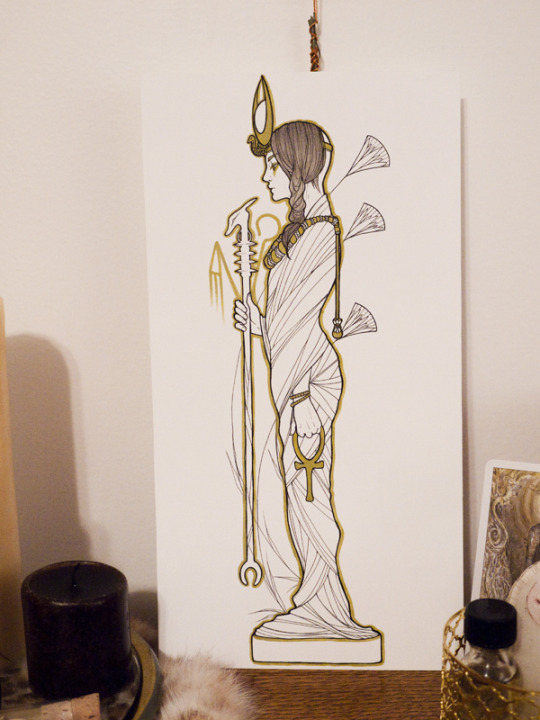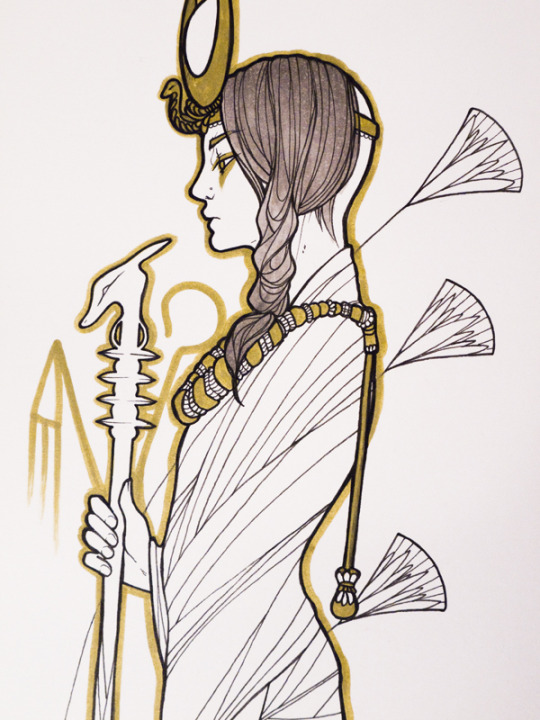Text
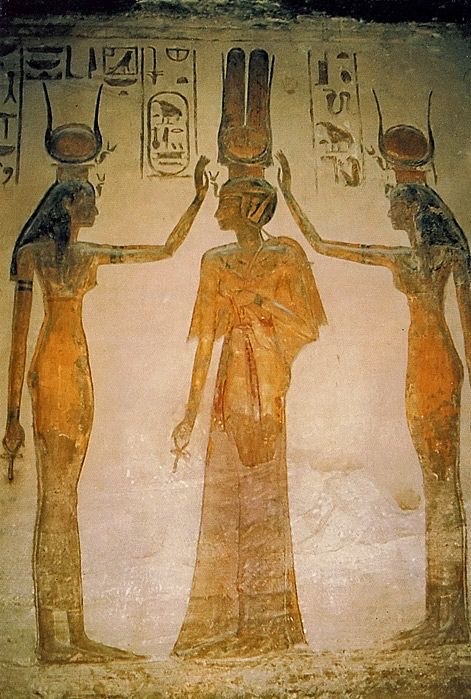
Painting inside the Queens Temple of Abu Simbel of the Goddesse Isis (right) and Hathor (left) blessing-the Queen.
203 notes
·
View notes
Photo

An emissary of Nebt-het reminds us that no memory is ever truly forgotten; no person is ever completely gone…
Nebt-het (Nebet-het, Nephthys) is an Ancient Egyptian goddess associated with mourning, death and the dead, protection, temples, and night/darkness. She is frequently depicted as a kite, as this bird of prey has a loud, piercing screech that sounds like a cry of mourning. She is a dedicated protector in both life and after death. May Nebt-het watch over all the people murdered by white supremacy. Black Lives Matter.
328 notes
·
View notes
Text
“The treatises [Book of the Solar-Osirian Unity] focus on the roots of the eastern horizon, the place of the unification of Re and Osiris, the final triumph of the nocturnal Sun and the Lord of the Dead, the place of firey birth of the newborn Sun and the final destruction of the damned […] Akephalos, whose head journeys with the barge of the Sun until it is reattached to the mummy at the eastern end of the Netherworld; the physically giant form of Osiris and the blessed dead at the eastern horizon, linking and filling heaven and hell.
The Ramesses VI version of the treatise [Book of the Solar-Osirian Unity] depicts and describes the pharaonic ancestor of the Helleno-Egyptian magical being Abraxas, the giant, omnipresent personification of the blasting and avenging power of the Sun”
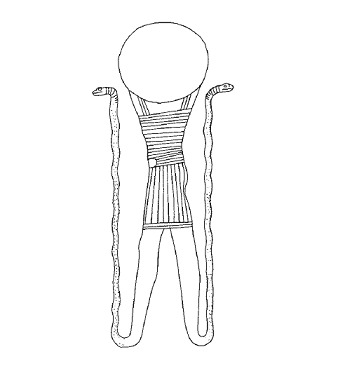
— John Coleman Darnel, The Enigmatic Netherworld Books of the Solar-Osirian Unity: Cryptographic Compositions in the Tombs of Tutankhamun, Ramesses VI and Ramesses IX.
28 notes
·
View notes
Text
The Triumph of the Moon: Wesir-Iaḥ
Worshiped as Lord of the Westerners and Sovereign of the Duat, Wesir is one of the most complex and most faceted gods in Egyptian religion. He was also revered as an entity related to the vegetation, harvests, reproduction, floods of the Nile … His vital impulse is considered so powerful that in Egyptian tradition is presented with the capacity of overcoming death, regenerating even after being fragmented by his brother Set. And among all these aspects, besides, is the connection of Wesir with the Moon.
Although the most powerful and important celestial body in Egyptian religious tradition was the Sun, the cult of the Moon also reached a certain significance. For example, the worship of Iah, “the white disk”, god who had a special role in the Middle Kingdom, stands out, although he generally appeared in deep fusion and identification with Wesir. Iaḥ, in turn, had close affinities with Djehuty, the multi-faceted god of the lunar nature, who is especially known as the patron of scribes, sciences and astronomy. In the fusion with Iaḥ (Djehuty- Iaḥ) he was considered “Sovereign of the Stars”, being worshiped as a beneficent and merciful deity, who can be known too as ‘’The Merciful’’, under the syncretic form of Wesir-Djehuty-Iaḥ. Anpu was also related to the Moon and could even appear represented taking care of the lunar disk.

Although possibly among the lunar divinities it was Khonsu, the son of the god Amun and the goddess Mut, who achieved greater notoriety. In some Theban sources, it is stated that Khonsu traveled every day from the Karnak temple in the east to the Djeme temple in the west (in the Medinet Habu area), to revitalize his father.
One of the most relevant aspects of the Egyptian tradition regarding lunar mythology was the relationship established between the night star and the eyes of Heru. Thus, the Moon is his wounded eye, a notion that derives from the confrontation between Horus and Set for the inheritance of Wesir, where it is stated that during the fight Set seizes the left eye of Heru to injure him and even break it into various parts that Djehuty will later unite. This “restored” lunar eye, the Wadjet-sign-Wadjet-eye, is one of the most recurring symbols in ancient Egyptian iconography, shaping popular amulets that are propitiate that its wearer could finally come out graceful before any contest.

In the context of symbolism that refers to regeneration, it’s where the relationship between the Moon and Wesir became especially close. This is because in its lunar period, made up of about 29 days, the nocturnal star is able to grow and diminish until it disappears, to start the cycle again with a new rebirth that allows it to achieve, once again, fullness. In this death and subsequent resurgence of the star in the sky, the Egyptians found a magnificent metaphor of life that is capable of recovering after death. It is a simile of the fundamental contents of the Osirian Cycle, in which it is narrated that the god dies in the confrontation with his brother, and then restarts eternal existence. So Wesir-Iaḥ reappears in the night sky, in a constant and invariable cycle that was converted into an allegory of life that reappears after death, expressing the power of existence and of the renewal that gives full life to what has succumbed.
Certainly, the course of the Moon, with its increasing and decreasing periods, was considered allegorically linked to the becoming of Wesir. The Waning aspect was related to the fragmentation suffered by Wesir; and the later recomposition and return to life were considered to be evoked in the increasing phase of the star in transit towards fullness. There are versions of the Osirian Cycle in which it is narrated that the god was fragmented by Set into 14 pieces, which coincides with the number of days that pass between the Moon and the New Moon. Even the life journey of Wesir was presented in close relationship with the lunar course: his conception was said to occur on the first lunar day or New Moon, his birth would come on the second day (which is when the Moon reappears in the heaven), murder and dismemberment would be associated with the Waning period, and, finally, the defeat of the enemies and the granting to Heru of their legitimate inheritance, would arrive on a Full Moon. In this divine calendar, eclipses were seen as a negative disorder, and, at least as expressed in the documentation of the Late Period, they were considered bearers of bad omens.
So Wesir-Iaḥ was worshiped in ancient Egypt as a divine entity alluding to regeneration and renewed life that achieves eternity. Some notions that in the Egyptian worldview are intrinsically related to fertility, procreation, and, by extension, with the growth of vegetation and agricultural production. The truth is that many processes of the tasks of the peasants, as is often the case in agrarian societies, were associated with different lunar phases. So it was considered that there were specific dates in the calendar that favored the best growth of plants for their sowing, as if the Moon affected the fertility of the earth. It seems, therefore, that the Egyptians believed that the Moon could affect their lives on very different levels, perhaps this explains why stelae were erected in Deir el-Medina in honor of the nocturnal star or that many festivities were linked to the lunar calendar. To this add that germination and the notion of fertility could be related to the moon because the lunar cycle and the menstrual period were even. Not for nothing did deities like Aset or Het-Heru come to present relevant lunar connotations; However, we must not forget the implications of fertility and masculine procreative strength of Wesir-Iaḥ where masculine vigor is sometimes evoked by assimilating it with a powerful bull:
“Oh He who appears as a Moon. Bull that rejuvenates in the sky every day ”.
Wesir-Iaḥ is represented mummified and crossing the scepter and the scourge on his chest, although it is still more common to be depicted as enthroned. However, its most characteristic feature is its crown, which can also be worn by other deities of a lunar nature, which is formed by the combination of the disk that symbolizes the full moon on a crescent-shaped representation, it is also recurrent that Wesir-Iaḥ is shown holding in his hands the udyat, the sacred lunar eye; or the udyat is represented on the god’s crown

The representations of Wesir-Iaḥ are not very frequent, although they reached a special boom in the Egypt of the Late Period and, especially, in the Greco-Roman Period, at which time, for example, bronze figurines representing this divinity became relatively popular. In these images, Wesir-Iaḥ appears, sometimes, placed on richly ornamented seats. In other cases, Wesir-Iaḥ may appear accompanied by other divine protective entities and considered as the entourage that assists him as he furrows the firmament. Among this divine entourage are 14 divinities identified as the 14 days that last the increasing or decreasing phases of the Moon. And sometimes Wesir-Iaḥ can be shown sailing the skies in a boat, just like the Sun itself and the stars.
Bibliography
-Neugebauer, R.A. Parker, Egyptian Astronomical Texts, vol.1, The early decans, Providence, 1960.
-P. Barguet, Le cycle lunaire d’après deux textes d’Edfou, RdE 29, 1977.
-F. R. Herbin, Un himne à la lune croissante, BIFAO 82, 1982.
-J. G. Griffiths, Osiris and the Moon in Iconography, JAE 62, 1976.
149 notes
·
View notes
Text

☀️Hatmehyt, Foremost of the Fish☀️
A piece for the BLM fundraiser commissioned by @syntheticlazurite
~please do not repost or remove caption thanks~
316 notes
·
View notes
Text
The Ogdoad’s Textual Amulet
Should be written in a piece of papyrus or good quality paper and carried with it’s owner.
Transcription:

Transliteration:
inḏ -<ḥr>=tn n3 ḫmnyw n3 nḥm-Pˁ -Rˁ m-ˁ f ḫty tpy nA nḥm Pˁ - Rˁ m- ˁ ḫfty sn.nw || n3 nḥm Pˁ - Rˁ m- ˁ ḥ ḫmt.nw n3 nḥm Pˁ - Rˁ m- ˁ ḫfty ifd.nw ir p3 nḥm i.ir=tn || Pˁ - Rˁ - ḥr-3ḫty m- ˁ ḫfty tpy [m-a ḫfty sn.nw m- ˁ ] ḫfty ḫmt.nw m- ˁ ḫfty ifd.nw mi.n || nḥm=tn [ ] ms.n [ ] m- ˁ iḫt nb bin ḏw m-mitt
Translation:
Hail to you, Oh Entities of Khemenu (Ogdoad), the ones who rescued Pa-Ra from the first enemy, the ones who rescued Pa-Ra from the second enemy, the ones who rescued Pa-Ra from the third enemy, the ones who rescued Pa-Ra from the fourth enemy! As for the rescue that you did of Pa-Ra-Horakhti from the first enemy, from the second enemy, from the third enemy, from the fourth enemy: Come, so you may rescue [Name] born of [Name] everything bad and evil, likewise!
Extracted, drawn, transcripted, translated and adapted from Papyrus MMA 26.3.225, ca.1292–1069 BC
100 notes
·
View notes
Photo

The uraeus visible at the far left of this image is the goddess Selkis / Selket; her name is written with a stylised scorpion holding two ankhs. Three snakes, called “Those on their bellies”, poke their heads in on the right. This scene is part of the Fourth Hour of the Amudat from Seti I’s tomb, as copied by Giovanni Belzoni.
33 notes
·
View notes
Text




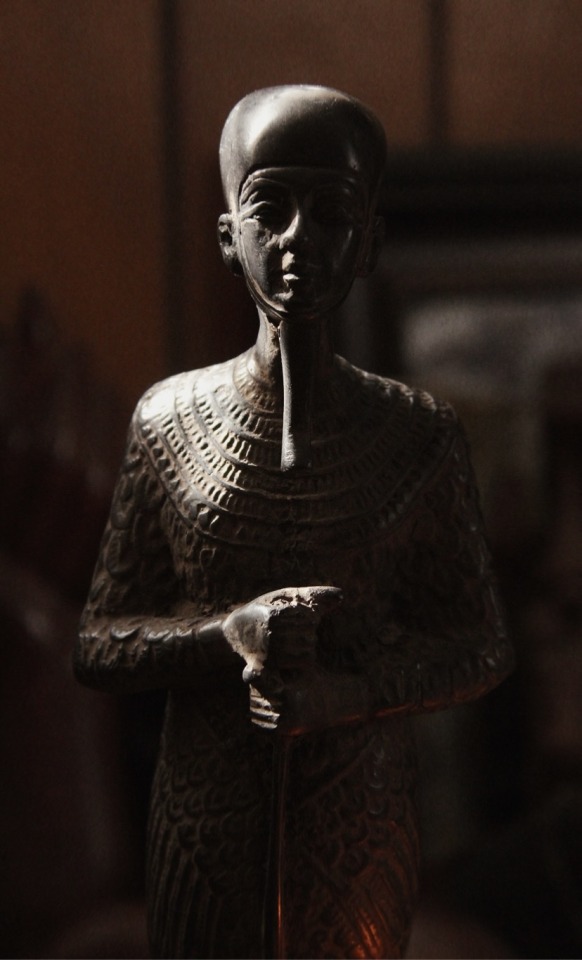
Bits of my altar featuring Aset, Wesir, and Ptah.
769 notes
·
View notes
Photo
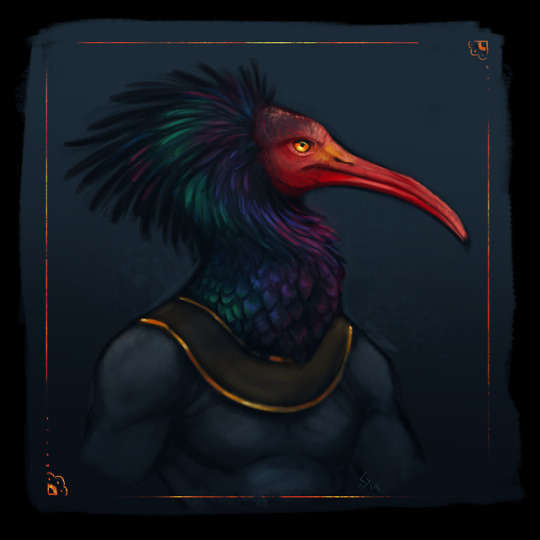
The Shining One The waldrapp, or Northern bald ibis ( Geronticus eremita ), once ranged into Egypt and was as sacred to Thoth as the so-named Sacred ibis ( Threskiornis aethiopicus ). Indeed, the heiroglyph for akh is a waldrapp. These critically endangered ibis are not waders, but adept hunters of lizards and frogs, and have striking glossy plumage that makes it easy to see why Thoth might be hailed as ‘resplendent’.
275 notes
·
View notes
Photo

Bronze Rearing Cobra
An Egyptian bronze Uraeus or the rearing cobra wearing the atef-crown. The flaring hood is inlaid with turquoise, carnelian, and lapis lazuli. Height with tenon: 4 9/16 in. 10.6 cm. Late Period to Ptolemaic Period, ca. 716-30 BC. Now in the Private Collection.
234 notes
·
View notes
Photo

Isis unveiling herself
Isis se dévoilant - Isis unveiling herself
Marble sculpture by André-Joseph Allar, (French, 1845-1926)
2K notes
·
View notes
Text
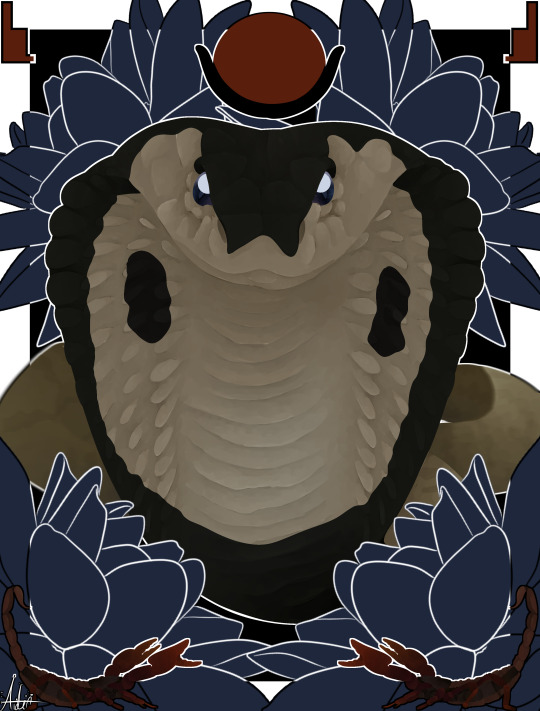
Amaaziiing artwork that @kemetic-worship did for me, it's Aset-Serqet in Cobra form.
Thank you so much!
97 notes
·
View notes
Text
I enjoyed so much doing this art for @kemetic-worship

Stunning piece of my lineup by @asethepetwi
Do not repost or use
104 notes
·
View notes
Text

Here's a double day for Bast and Sekhmet from Egyptian mythology. Bast is on the right, Sekhmet is on left.
Bast (also known as Bastet) is the goddess of cats, home, music, dance, and pleasure. Sekhmet is a goddess of the sun, war, destruction, plague and healing.
"Call on Bast when you want to rediscover the joys of laughter and pleasure to move through your own grief." - Ann Shen, 'Legendary Ladies'
"Call on Sekhmet when you need deep healing and strength, she reminds you that you are stronger than you think you are." - Ann Shen, 'Legendary Ladies'
405 notes
·
View notes
